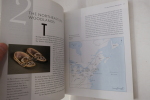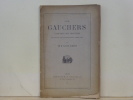-
Type
Book (1990)
Magazine (62)
-
Latest
Last 3 days (1)
Last month (27)
Last week (2)
-
Language
English (4)
French (2046)
Portuguese (1)
Spanish (1)
-
Century
16th (1)
17th (2)
18th (6)
19th (168)
20th (1019)
21st (165)
-
Countries
Belgium (187)
Brazil (19)
Canada (4)
Côte d'Ivoire (15)
Denmark (3)
France (1682)
Germany (1)
Italy (24)
Switzerland (117)
-
Syndicate
ALAC (3)
CNE (1)
ILAB (965)
NVVA (39)
SLACES (39)
SLAM (878)
La foire aux dinosaures
Seuil In-8°, broché, couverture souple illustrée (Dinocanard), ensemble dense, 490 pages, figures dans le texte, biblio in fine (465-473), ensemble de seconde main un peu gauchi en en bonne condition sous tous rapports.
Bon Etat Franco de port France jusqu'à 29 euros iclus. MONDIAL RELAY pour : FRANCE, Portugal, Pologne, Espagne, Allemagne, Autriche, Pays Bas, Luxembourg, Italie, Belgique. Toutes les étapes sont accompagnées. Achat, estimations et listages France / Suisse (sur rdv).
La structure de la théorie de l'évolution
Gallimard Gallimard, 2006. Très fort et grnad in-8 relié pleine toile éditeur sous jaquette de 2033 pages. Rares passages soulignés discrètement au crayon de papier sinon très bon état
Toutes les expéditions sont faites en suivi au-dessus de 25 euros. Expédition quotidienne pour les envois simples, suivis, recommandés ou Colissimo.
L'évantail du vivant
Seuil In-8°, broché, couverture souple sobre de l'éditeur, 304 pages, figures dans le texte, bibliographie et index.
Bon Etat Franco de port France jusqu'à 29 euros iclus. MONDIAL RELAY pour : FRANCE, Portugal, Pologne, Espagne, Allemagne, Autriche, Pays Bas, Luxembourg, Italie, Belgique. Toutes les étapes sont accompagnées. Achat, estimations et listages France / Suisse (sur rdv).
First peoples first contacts
1999, British Museum Press. In-8, broché, 288pp. Riche iconographie n&b et couleurs. Bon exemplaire //// In-8, softcover, 288pp. Numerous illustrations b&w and colours. Good copy
L'anthropologie sciences des sociétés primitives ? - Collection le point de la question.
E.P.. 1971. In-8. Relié. Bon état, Couv. convenable, Dos satisfaisant, Intérieur frais. 308 pages - nombreuses illustrations en noir et blanc dans et hors texte.. . . . Classification Dewey : 306-Anthropologie
Collection le point de la question. Classification Dewey : 306-Anthropologie
Les applications de l'anthropologie : un essai de réflexion collective depuis la France, Editions Karthala, 1995
16 cm X 24 cm, 282 pp. Couverture souple. Broché.
Bords un peu frottés, tranches salies. Petites traces de pliure sur les plats et les coins. Quelques piqures. Très bon état par ailleurs. Intérieur frais.
L'Afrique aux trois visages
Librairie de l'Université F. Rouge & Cie S.A 1944 257 pages in8. 1944. broché. 257 pages.
Etat correct
Diskurs über die Ungleichheit. Discours sur l'inègalitè: Kritische Ausgabe des integralen Textes. Mit sämtlichen Fragmenten und ergänzenden ... ... und den Handschriften. Französisch-Deutsch
UTB Stuttgart 2008 632 pages 18 4x2 8x12cm. 2008. Broché. 632 pages.
bon état de conservation intérieur propre tranche ternie
LES CHASSEURS DE MAMMOUTHS EN BRETAGNE.
OUEST FRANCE. 1982. In-8. Broché. Etat d'usage, Couv. légèrement passée, Dos satisfaisant, Intérieur acceptable. 30 pages - nombreuses photographies et dessins en couleurs et en noir et blanc dans et hors texte.. . . . Classification Dewey : 306-Anthropologie
Photgraphies de l'auteur - dessins couleurs de Loys Petillot. Classification Dewey : 306-Anthropologie
ANTHROPOLOGIE SEXUELLE / COLLECTION RECHERCHES ECONOMIQUES ET SOCIALES
AUBIER-MONTAIGNE. 1964. In-12. Broché. Etat d'usage, Couv. convenable, Dos satisfaisant, Intérieur frais. 204 pages.. . . . Classification Dewey : 306-Anthropologie
Classification Dewey : 306-Anthropologie
Terrorisme et culture - Les sept épées Cahiers de la fondation pour les Etudes de défense nationale - n°20 - Centre d'Etudes et de recherches sur les stratégies et les conflits -supplément au numéro 11 - de Stratégique -
Stratégique 1981. 1979. In-8. Broché. Bon état, Couv. convenable, Dos satisfaisant, Intérieur frais. 215 pages.. . . . Classification Dewey : 306-Anthropologie
supplément au numéro 11 - de Stratégique - Classification Dewey : 306-Anthropologie
La mort chez les peuples altaiques anciens et médiévaux
Ed. de la librairie d'Amérique et d'Orient.1963.Grand in 8 de 215 p.Couverture rouge.
Très bon état.Nombreuses notes en bas de page.Une mention manuscrite en fin de volume.Une très petite tache d'humidité en coin supérieur des dernières pages.
Monuments en pierres sèches du Fadnoun (Tassili n'Ajjer)
1966, éditions Arts et métiers graphiques, Préface de Gabriel Camps, Mémoires du C.R.A.P.E. conseil de la recherche scientifique en Algérie VI , in-4 (21 x 27 cm), broché, 16 planches en noir & blanc hors texte, dont une carte dépliante infine, 4 pages photos en noir & blanc.
Neuf
Phone number : 04 96 21 81 64
Figures,idoles,masques
Ed. julliard,col. confèrences du collège de France.1990.In 8 br. de 247 p.
Etat de neuf.
"Les Méthodes Structuralistes dans les Sciences Sociales"
"1965. La Haye et Paris Éditions Mouton & Co et Maison des Sciences de l'Homme 1965 - Broché 16 cm x 24 cm 246 pages - Texte de Jean Viet importante bibliographie - Bon état"
Dictionnaire d'Anthropologie ou Histoire naturelle de l'homme et des races humaines…
1853 in-8, 1600 col., br. (sans ses couvertures) P. Migne, 1853,
Phone number : 33 (0)6 77 77 12 33
Dictionnaire d'anthropologie, ou Histoire naturelle de l'homme et des races humaines. Anatomie, physiologie, psychologie, ethnologie [..] Réfutation des théories matérialistes, panthéistes, rationalistes, etc.
Petit-Montrouge, chez J.-P. Migne 1853 [800] pp., (texte imprimé en 2 colonnes, 1600 au total), illustré de 30 dessins ("types de races humaines"), 28cm., reliure cart. (plats marbrés, dos en cuir avec titre et faux-nerfs dorés, avec traces d'usage), peu de rousseurs, dans la série "Nouvelle encyclopédie théologique" tome 42 (tome unique), poids: 1.6kg., R107309
Encyclopédie illustrée de l'Homme préhistorique.
P., Gründ, 1980, gr. in-8°, 560 pp, 860 photos et dessins en noir dans le texte et sur 64 planches en couleurs, chronologie, lexique, biblio, index, reliure toile éditeur, jaquette illustrée, bon état
Venant de Tchécoslovaquie, cet ouvrage est l'un des rares destiné au grand public qui aborde sérieusement l'habitation paléolithique. Faisant aussi une large place à la technologie et à l'art, ce livre résume très bien l'école de pensée et les résultats obtenus par les chercheurs des pays de l'Est. Un chapitre est également consacré à l'évolution physique de l'homme. (Jean-Pierre Jorrand, Revue archéologique de l'Oise, 1978) — Table : Les origines du développement de l'homme ; L'outillage en pierre taillée, fabrication et usage ; Demeures et habitats des hommes du paléolithique ; L'art paléolithique.
Les origines de la culture humaine - Collection Bibliothèque Scientifique.
Payot. 1951. In-8. Broché. Etat d'usage, Couv. légèrement passée, Coiffe en pied abîmée, Papier jauni. 354 pages - rousseurs sur les plats - nombreuses figures en noir et blanc dans le texte.. . . . Classification Dewey : 306-Anthropologie
Collection Bibliothèque Scientifique - Traduction et préface de D.P.De Pedrals. Classification Dewey : 306-Anthropologie
A bed of ochre. Mortuary practices and social structure of a maritime archaic indian society at Port au Choix, Newfoundland
Groningen, 2000 xiv + 332pp., with few ills., + 1p. Theses, 23cm., text in English, softcover, Doctoral Dissertation (Rijksuniversiteit Groningen), stamp at verso of title page, text is clean and bright, G110472
The Philosophy of Grammar (Norton Library) (Norton Library (Paperback))
W. W. Norton & Company 1965 360 pages 12 8x2 6x20 2cm. 1965. Broché. 360 pages.
bon état couverture légèrement défraîchie intérieur propre
Letterkundig overzigt en proeven van de Nederlandsche volkszangen sedert de XVe eeuw.
1828 317 p., title-page with nice engraved vignette, contemporary boards (somewhat soiled and upper end spine damaged).
Les gauchers comparés aux droitiers aux point de vue anthropologique et médico-légal.
Imprimerie Nouvelle Lyon 1885 In-4 ( 250 X 165 mm ) de 68 pages, broché. Edition originale. Thèse de doctorat de médecine soutenue à Lyon devant Alexandre LACASSAGNE. Couverture effrangée, bon exemplaire, non coupé.
World of Athens: An Introduction to Classical Athenian Culture (Joint Association of Classical Teachers' Greek Course)
Cambridge University Press 1984 407 pages 14 8x2 8x20 6cm. 1984. Broché. 407 pages.
Très Bon Etat de conservation intérieur propre bonne tenue
Comprendre l'homme, I : Introduction à une anthropologie philosophique.
1969 Paris, Le Cerf (Collection "Cogitatio Fidei" N°26), 1967, in 8° broché, 302 pages ; index des auteurs cités ; des passages soulignés au crayon ; petites traces de ruban achésif sur les gardes.
...................... Photos sur demande ..........................


Phone number : 04 77 32 63 69
 Write to the booksellers
Write to the booksellers

















